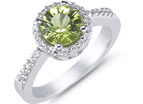
Peridot
Rings
'Peridot' comes from the ancient Greek which
translates roughly as "to give richness". Some controversy about this gemstone
exists today – if only in the pronunciation of the word "peridot". The first is
almost French-like in its inflection: 'pare – ee – doh'. The second is
more English sounding and somewhat more respectful of the final consonant: 'perry
– dot'. Either way, the peridot remains, as the ancient Egyptians referred to
it,' the gem of the sun'.
Specifically, the peridot is a variety of the
mineral 'olivine'. In Biblical times, as noted in Exodus, a variety of the
peridot known as chrysolite was said to be the stone which represented Simeon,
the second son of Jacob, on the Hoshen – or breast plate of Aaron.
Ranging in color from a yellow-green to
chartreuse, the most popular shade of the peridot is a vivid lime green with a
slightly gold cast – the gold color being due to traces of iron. Considering
that olivine is the source mineral, it's ironic that the ideal peridot should
have no 'olive' tones at all.
Next:
Peridot Jewelry Origins
 View our Entire Line of
Peridot Rings and
Gemstone
Rings.
View our Entire Line of
Peridot Rings and
Gemstone
Rings.





![]()